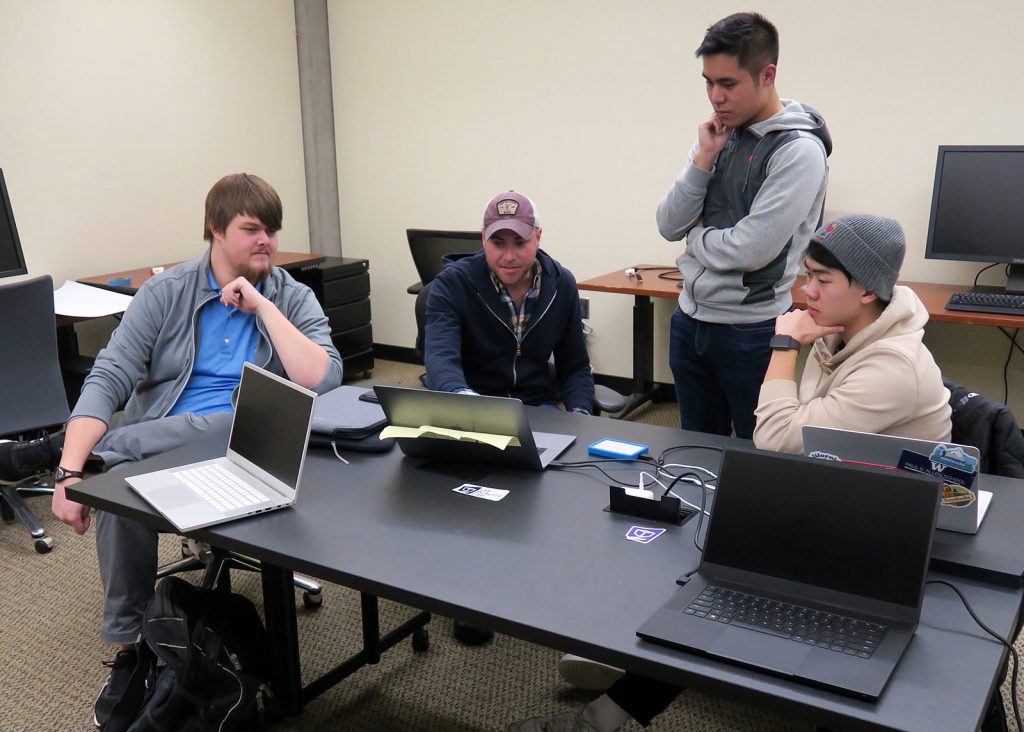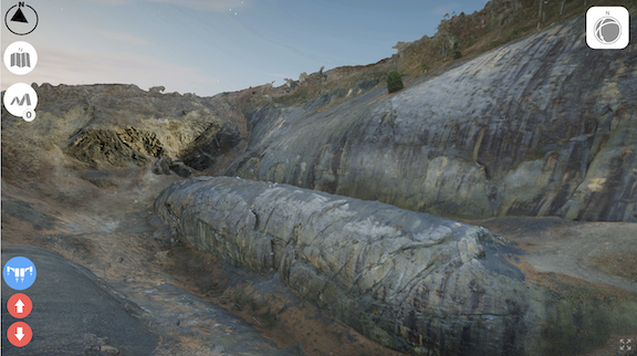
In the coal region of Shamokin, Pennsylvania, an impressive geological structure called the Whaleback Anticline has become a natural classroom for geology students. The former strip mine is a geological formation that looks like the back of a whale. Max Needle, a Pennsylvania native and geology graduate student in the University of Washington’s Department of Earth and Space Sciences (ESS), knows the site well. With a camera, a drone and support from his faculty advisor Juliet Crider and fellow graduate student Keith Hodson, Needle built a 3D digital replica of the site with the intention of giving more students access to this geological wonder.
The anticline, which is on private land, requires special permission to visit and is not easy to navigate due to its enormity. The project began with the idea of making the site inclusive, accessible and available to students that could not get to it in person but turned out to be a vital experience for undergraduate geology students forced to cancel site visits because of the COVID-19 pandemic.
When Needle took his digital replica to the UW’s Reality Lab last January to get help with the program, the Allen School students would take the project in an exciting new direction by turning his mobile 3D tour of the Whaleback into an online classroom — and eventually, a virtual reality experience.
“The CS students that worked on the project with me went above and beyond my expectations,” Needle said. “They finished the initial project pretty quickly and asked what my dream for this project might be and took it to the next level.”
Allen School senior Jacky Mooc and sophomore Andrew Wang worked with Needle on his project as undergraduate researchers in the Reality Lab. Tasked with creating a virtual tour of the Whaleback, with stops for users to learn more about its history and geological features, Mooc and Wang got to work. But as they neared completion, the pandemic hit and classes moved online. Because geography students wouldn’t be able to travel to do field work over the summer, Needle, Mooc and Wang pivoted away from moving the application into virtual reality and focused instead on adding more functionality to it. In addition to enabling students to explore the Whaleback site on the ground or through the air, the team moved the program to WebGL and added a robust measuring system that simulates the types of measurements geologists take when physically visiting sites. The programming language renders interactive 2D and 3D graphics allowing for greater accessibility. The group also added an extensive tutorial and traceable tour stops featuring puzzles and quizzes, essentially turning it into a game. After the initial summer course, the team can now implement the program in VR.

“Even though we only recently began to implement the Whaleback project into VR, mainly because the scope for the WebGL version grew, developing for it has been very promising so far,” said Mooc. “There are lots of outside tools to use in Unity that make developing for VR faster. And luckily, since I joined this project, I have taken two courses in storytelling in VR at the Allen School, which gave me experience with Unity, and maybe more importantly, taught a lot about VR design considerations. However, this project still warranted a lot of self-learning in order to use Unity and SteamVR.”
Last summer, the first iteration of the virtual geology experience based on Needle’s work was used as part of an online version of an ESS summer field course. Jacob Childers, who completed his B.S. in geoscience last summer, enjoyed the opportunity to tour the geographic formation virtually since traveling was not an option.
“I was initially excited that there was a chance to study the Whaleback remotely. We had been using tools like Google Earth and ARCgis for the bulk of our remote field experience, so it was exciting to try something new, but I was a little nervous that it wouldn’t be very useful,” he said. “I really enjoyed the Whaleback experience more than I thought I would. The program was pretty user friendly and the controls were pretty smooth and intuitive to use.”
Childers said that the game did a good job showing the scale of the Whaleback and had a lot more detail than he expected—but he had some feedback for the developers.
“As a geologist, I enjoyed the game but I wish that we could make more observations aside from determining the axes of folds and taking strike and dip measurements,” he said. “In terms of strike and dip measurements and taking stereonets, this program had a large advantage over programs like Google Earth, so this was a really nice supplement.”

After hearing Childers’ feedback, Mooc went back and designed a prefab in Unity 3D for designers to create a greater level of detail for future models or games, if they think it’s necessary.
“Rather than using a higher-res version of a 3D model and really bogging down the machine of the user, there’s now a way to click on objects and read about features in greater detail and see pictures at a higher-res or even microscopic scale,” Needle explained. “This new prefab is in the works for a new game that we’ll release as part of an ESS 212 course in three weeks.”
Needle and the team are open to feedback and he has continued to use the program the team built in additional ESS classes. A demonstration of the Whaleback Anticline Field Adventure is available to watch, and anyone interested in trying it out can do so at www.virtualfieldgeology.com. It will be available for Oculus VR, and also in Unity so it can be adapted later for iOS or XBox, in the spring.

